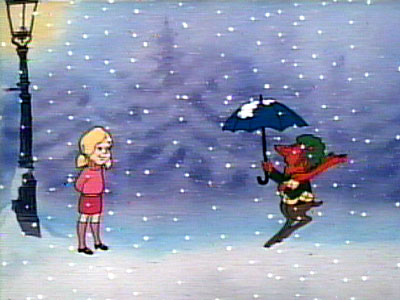 |
| Lesson 1 Never wear fur when you're messiah is a giant cat |
When it comes to love for either a person, place, or
work of art there is truly no accounting for taste. As a result, for many
viewers, films that were once viewed as ‘classics’ during childhood often lose
their luster when viewed years later. This week I’ll be reviewing a childhood
film that was beloved throughout my childhood although it hardly qualifies as a
classic; the 1979 animated adaptation of C. S. Lewis’ classic fantasy The Lion The Witch and the Wardrobe.
The film follows the story of Lewis’ novel and
chronicles the adventures of the four Pevensie siblings; Peter, Susan, Edmund,
and Lucy. The film begins with the children staying at the country home of
Professor Kirke, but fails to explain why the children are staying there (the
novel stated that the children are staying at the home after being evacuated
during the London Blitz), which leaves the events of the story without the
historical backdrop that provided the novel with added emotional weight. During
their stay, youngest sibling Lucy discovers a portal to a magical world through
an old wardrobe, marking the beginning of the children’s adventures. It is
during this first visit to Narnia, a land populated with mythical creatures and
talking animals, that Lucy befriends faun Mr. Tumnus, who unbeknownst to her initially
plans to turn her over to the wolves who make up Narnia’s Gestapo-esque secret
police. After having a conversation with the curious and amiable Lucy, however,
Tumnus finds himself unable to betray the little girl’s trust and safely guides
her home only to later be arrested for his efforts. Eventually, Lucy’s other
siblings join her in Narnia and all four children find themselves embroiled in
a resistance effort to overthrow the White Witch who has oppressed the land and
restore its rightful ruler, talking lion Aslan, to his throne.
While the film may have been dazzling upon initial
viewing for many children, the quality of its animation is laughable when
compared to either the likes of today’s computer animation or skillful
traditional animation from major motion picture companies like Disney. Throughout
the film, characters move about in a stilted way, make unnatural facial
expressions, and often fail to open their mouths when they speak, creating the
unusual illusion that they are actually talking through their teeth. Also,
while the human characters are more realistically drawn, the talking animals
that populate Narnia are often drawn in such a ‘cartoonish’ way that the two
sets of characters seem as though they belong in separate films. Perhaps the
most noticeable laziness on the animators’ part is the recurring use of a
handful of images that are recycled throughout the film for its chase scenes that
are so limited as to make the stock backgrounds of such television shows as The Flinstones and The Jetsons appear expansive.
 |
| Did Red Riding Hood teach you nothing about talking to strangers?! |
While the film’s animation is certainly lacking, the
film’s creators did do justice to the original source by closely following the
original novel. The film refuses to shy away from the obvious religious subtext
of the story and instead remains true to Lewis’ original intention by
portraying Aslan’s persecution and subsequent resurrection as a child-friendly
metaphor for the tale of Christ. By following the story’s original allegory,
the film provides the story with the gravitas and depth that made the original
a bestselling classic. The film also maintains many of the secondary characters
from the novel, which in turn allows for Narnia to truly feel like a world unto
itself full of its own mixture of social classes, species, and political
allegiances. Fortunately, the voice-over performances also capture the
personalities of the characters in such a way that brings them to life and
propels audiences’ investment in their struggles. Unfortunately, however, the
lack of any mention of World War II and the animators’ use of 1970’s fashions
places the story out of its original historical context and therefore removes
the parallels between the Allied struggle against Axis forces and the similar
struggle between Aslan’s supporters and the forces of the White Witch.
While it is certainly no Oscar contender, this
adaptation will always remain my favorite version of the C. S. Lewis classic.
The film successfully manages to relate the original novel’s expansive drama
into a manageable ninety-five minutes without sacrificing any substance or
depth. While its rudimentary animation would spur more laughs than wonder
today, there is no denying the film’s ability to transport young viewers to the
magic and amazing world that is Narnia. While I’ll be first to point out the
film’s many technical flaws, I can’t deny the memories of wonder and
possibility that come flooding back to me each time I put on my scratchy old VHS
copy. In the end, isn’t it that sense wonder and possibility that movies are
all about?
 |
| Turkish Delight: Making chocolate uncomfortably sexual since 1979 |

Mr. Tamnus makes me feel EXTREMELY uncomfortable in this adaptation. So much so that I feel like he should be required to read a Court Ordered Notice every time he moves somewhere in Narnia...
ReplyDeleteThis comment has been removed by the author.
ReplyDelete